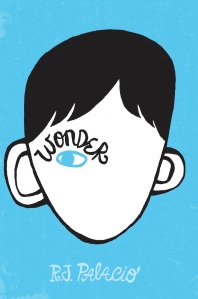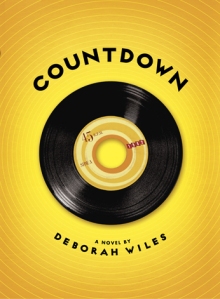By Megan Frazer Blakemore
“For me, Halloween is the best holiday in the world. It even beats Christmas. I get to dress up in a costume. I get to wear a mask. I get to go around like every other kid with a mask and nobody thinks I look weird. Nobody takes a second look. Nobody notices me. Nobody knows me.”
– August Pullman in Wonder by R.J. Palacio (p. 73)
 Who hasn’t wanted to use Halloween as a chance to show off a different, hidden side of oneself? Perhaps this explains all the “sexy” Halloween costumes for women and girls: sexy nurse, sexy fire fighter, and my personal favorite, Sassy Rick Grimes (though I myself would prefer a “sassy” Darryl Dixon). For children, whose lives are constricted by parents, teachers, and friends, this instinct is especially strong. Alternatively, costumes can give children a chance to not only face their fears, but also to become them, and thus conquer them.
Who hasn’t wanted to use Halloween as a chance to show off a different, hidden side of oneself? Perhaps this explains all the “sexy” Halloween costumes for women and girls: sexy nurse, sexy fire fighter, and my personal favorite, Sassy Rick Grimes (though I myself would prefer a “sassy” Darryl Dixon). For children, whose lives are constricted by parents, teachers, and friends, this instinct is especially strong. Alternatively, costumes can give children a chance to not only face their fears, but also to become them, and thus conquer them.
Costumes also offer an opportunity for writers to reveal their characters. For the use of costumes to be interesting, the outfits must do more than simply telegraph aspirations, or provide a chance for literary acrobatics in their description. Rather, like everything else in fiction, costumes must be chosen and used to serve the story. R.J. Palacio’s Wonder (Knopf, 2012) and Deborah Wiles’ Countdown (Scholastic 2010) offer two different ways to use costumes to advance the plot and the emotional arc of their stories.
The quote at the start of this post comes from August Pullman, the main protagonist of Palacio’s Wonder. These could be the musings of any typical middle schooler, but Auggie is not typical. He was born with a facial deformity that has led to 27 surgeries in his short life. Homeschooled through his childhood, he decides to attend fifth grade at a seemingly open-minded and open-hearted private school.
Auggie gets his wish that no one will know him on Halloween, but it is a bitter fruit. At the last minute he decides to change his costume from Boba Fett to the Bleeding Scream. This means that none of his new classmates recognize him, including Jack, who Auggie thought was a friend. The outcome is a devastating scene in which Jack, trying to fit in, participates in a cruel discussion of Auggie’s appearance, not knowing that Auggie is sitting right there:
The mummy shrugged. I knew the shrug, of course. I knew the voice. I knew I wanted to run out of the class right then and there. But I stood where I was and listened to Jack Will finish what he was saying. “I mean, the thing is: he always follows me around. What am I supposed to do?” (p. 77).
For so long August has wanted to be known for who he is, not his face, but this time the disguise ends up being what hurts him. He runs to the bathroom where he collapses in tears, chastising himself for not knowing better.
Wonder is a novel about surfaces and about lenses: each scene is told and retold by several narrators. How they perceive and react to August and the events of his story work together for a complete picture, much like a prism refracting light in different directions. The book has a built-in motto, “Choose kind,” and Jack’s behavior shows the consequences of not choosing to be kind. Later, when Jack realizes what he’s done, he thinks:
And I don’t know why I said that stuff. I was just going along. I was stupid. I am stupid. Oh God. He was supposed to come as Boba Fett! I would never have said that stuff in front of Boba Fett. But that was him, that Bleeding Scream sitting at the desk looking over at us. The long white mask with the fake squirting blood. The mouth wide open. Like the ghoul was crying. That was him. I felt like I was going to puke. (p. 152)
The message — and this is indeed a message-heavy book — is that one needs to be kind no matter who is around — your parents, your teachers, Boba Fett, or the Bleeding Scream. The costumes allow Palacio to share this message deftly.
Deborah Wiles’ Countdown is a documentary novel of the Cuban Missile Crisis: interspersed among the text are photographs, news articles, song lyrics, and other ephemera from the early 1960s. Set against this tense backdrop, Franny deals with family issues including an uncle damaged by war and a sister involved in underground activities. Yet it is the plot of a broken friendship and early loves that makes the novel universal and accessible to today’s readers.
Key to this plot is a Halloween party. The party thread starts with Franny shooting off her mouth in an awkward moment with old friend and new crush, Chris. As the novel goes on, and the drama between the Franny and her ex-best friend Margie escalates, the Halloween party serves as a highlighter. When Franny fears she is losing Margie to popular girl, Gale, it comes out that Gale is having her own party. When Franny and Margie get in a fight at school, Gale takes Margie’s side with the teachers, but later comes to invite Franny to the party. Franny wants to go with Chris, but fears Margie has invited him — and they do show up together. The party ends up being the climax of the tension between the girls right down to a shouting match and Margie storming out of the party.
Wiles’ use of costumes in this scene is particularly strong. Like Auggie, Franny makes a last minute switch in costume — from Hobo to Gypsy — with the help of her sister. This represents her shift from youthful, ugly duckling, to a girl who is maybe willing to see herself as a swan. Chris, the love interest, comes “dressed as — I kid you not — Superman” (p. 319) Gale, who has been ensconced in her aura of popularity, does not dress as a glamour-pot, but as a hobo:
A hobo! She’s wearing baggy pants and suspenders and her hair is in pigtails — she looks like Pippi Longstocking, but with thick black braids. She’s got freckles painted on her face. She’s grinning like she just won the big prize on a television game show.” (p. 314).
With this description Wiles makes it clear that Gale is no longer a threat. In contrast, Margie has been striving to be the perfect model of popularity, and as the party begins, it seems she has achieved her goal. She comes as a princess:
She’s wearing a crown — a tiara — just like Miss America’s, and she’s dressed like Cinderella, like Sleeping Beauty, like the most beautiful princess in the world in a flowing blue gown with pearls in her hair. Her face however, is all evil stepmother. (P. 318).
A crack is now visible in her facade: that angry face. By the time she storms out of the party, she “runs down the the front steps, tripping and falling over her princess dress and sprawling into the front walk, where she pops up like a jack-in-the box …” (p. 323). Clearly Wiles uses costuming at different levels for each character. Chris’s costumes is fairly straightforward: he is the all-American good guy. Margie’s depiction is more nuanced: though she looks beautiful, she is literally falling over her own superficiality.
Halloween is just a few days away, writers. You may be too busy polishing your sexy Emily Dickinson or sassy David Foster Wallace costume for a reading break, but once you’ve finished celebrating, sit down with a bowl of leftover Halloween candy and check out one or both of these novels. You just may get inspired to include the pageantry of Halloween in your own manuscript. Whether you are using costumes to underline your themes or to further character development, there is much to learn from these two works for young readers. If nothing else, you’ll enjoy two spectacular stories.
 Megan Frazer Blakemore is the author of Secrets of Truth & Beauty (Disney-Hyperion, 2009) and The Water Castle (Walker, 2013). Stay tuned for her take on Halloween costumes in The Spy Catchers of Maple Hill, coming in May of 2014 from Bloomsbury. Find her online at www.meganfrazerblakemore.com and on twitter @meganbfrazer.
Megan Frazer Blakemore is the author of Secrets of Truth & Beauty (Disney-Hyperion, 2009) and The Water Castle (Walker, 2013). Stay tuned for her take on Halloween costumes in The Spy Catchers of Maple Hill, coming in May of 2014 from Bloomsbury. Find her online at www.meganfrazerblakemore.com and on twitter @meganbfrazer.
